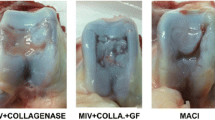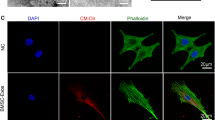Abstract
The aim of this study was to investigate the effect of transplanted chondrocytes on endochondral bone formation in cartilage repair tissue. In the knee joint of miniature pigs, cartilage lesions were treated by microfracturing and were then either left empty, covered with a collagen membrane, or treated by matrix-associated autologous chondrocyte transplantation. In control lesions, the subchondral bone plate was left intact (partial-thickness lesion). The repair tissues were analyzed after 12 weeks by histological methods focusing on bone formation and vascularization. The effect of chondrocytes on angiogenesis was assessed by in vitro assays. The presence of antiangiogenic proteins in cartilage repair tissue, including thrombospondin-1 (TSP-1) and chondromodulin-I (ChM-I), was detected immunohistochemically and their expression in chondrocytes and bone marrow stromal cells was measured by quantitative RT-PCR. Significant outgrowths of subchondral bone and excessive endochondral ossification within the repair tissue were regularly observed in lesions with an exposed or microfractured subchondral bone plate. In contrast, such excessive bone formation was significantly inhibited by the additional transplantation of chondrocytes. Cartilaginous repair tissue that resisted ossification was strongly positive for the antiangiogenic proteins, TSP-1 and ChM-I, which were, however, not detectable in vascularized osseous outgrowths. Chondrocytes were identified to be the major source of TSP-1- and ChM-I expression and were shown to counteract the angiogenic activity of endothelial cells. These data suggest that the resistance of cartilaginous repair tissue against endochondral ossification following the transplantation of chondrocytes is associated with the presence of antiangiogenic proteins whose individual relevance has yet to be further explored.







Similar content being viewed by others
References
Steadman JR, Rodkey WG, Rodrigo JJ (2001) Microfracture: surgical technique and rehabilitation to treat chondral defects. Clin Orthop Relat Res 391(Suppl):362–369
Mithoefer K, Williams RJ III, Warren RF, Potter HG, Spock CR, Jones EC, Wickiewicz TL, Marx RG (2005) The microfracture technique for the treatment of articular cartilage lesions in the knee. A prospective cohort study. J Bone Joint Surg Am 87:1911–1920
Kreuz PC, Steinwachs MR, Erggelet C, Krause SJ, Konrad G, Uhl M, Sudkamp N (2006) Results after microfracture of full-thickness chondral defects in different compartments in the knee. Osteoarth Cartilage 14:1119–1125
Brown WE, Potter HG, Marx RG, Wickiewicz TL, Warren RF (2004) Magnetic resonance imaging appearance of cartilage repair in the knee. Clin Orthop Relat Res 21:4–223
Saris DB, Vanlauwe J, Victor J, Haspl M, Bohnsack M, Fortems Y, Vandekerckhove B, Almqvist KF, Claes T, Handelberg F, Lagae K, van der Bauwhede J, Vandenneucker H, Yang KG, Jelic M, Verdonk R, Veulemans N, Bellemans J, Luyten FP (2008) Characterized chondrocyte implantation results in better structural repair when treating symptomatic cartilage defects of the knee in a randomized controlled trial versus microfracture. Am J Sports Med 36:235–246
Wasiak J, Clar C, Villanueva E (2006) Autologous cartilage implantation for full thickness articular cartilage defects of the knee. Cochrane Database Syst Rev 3:CD003323
Knutsen G, Drogset JO, Engebretsen L, Grontvedt T, Isaksen V, Ludvigsen TC, Roberts S, Solheim E, Strand T, Johansen O (2007) A randomized trial comparing autologous chondrocyte implantation with microfracture. Findings at five years. J Bone Joint Surg Am 89:2105–2112
Hiraki Y, Mitsui K, Endo N, Takahashi K, Hayami T, Inoue H, Shukunami C, Tokunaga K, Kono T, Yamada M, Takahashi HE, Kondo J (1999) Molecular cloning of human chondromodulin-I, a cartilage-derived growth modulating factor, and its expression in Chinese hamster ovary cells. Eur J Biochem 260:869–878
Gelse K, Muhle C, Knaup K, Swoboda B, Wiesener M, Hennig F, Olk A, Schneider H (2008) Chondrogenic differentiation of growth factor-stimulated precursor cells in cartilage repair tissue is associated with increased HIF-1alpha activity. OsteoarthCartilage 16:1457–1465
Mainil-Varlet P, Aigner T, Brittberg M, Bullough P, Hollander A, Hunziker E, Kandel R, Nehrer S, Pritzker K, Roberts S, Stauffer E (2003) Histological assessment of cartilage repair: a report by the Histology Endpoint Committee of the International Cartilage Repair Society (ICRS). J Bone Joint Surg Am 85-A(Suppl 2):45–57
O’Driscoll SW, Marx RG, Fitzsimmons JS, Beaton DE (1999) Method for automated cartilage histomorphometry. Tissue Eng 5:13–23
Sanz L, Pascual M, Munoz A, Gonzalez MA, Salvador CH, Alvarez-Vallina L (2002) Development of a computer-assisted high-throughput screening platform for anti-angiogenic testing. Microvasc Res 63:335–339
Aigner T, Zien A, Gehrsitz A, Gebhard PM, McKenna L (2001) Anabolic and catabolic gene expression pattern analysis in normal versus osteoarthritic cartilage using complementary DNA-array technology. Arth Rheum 44:2777–2789
Grimmer C, Balbus N, Lang U, Aigner T, Cramer T, Muller L, Swoboda B, Pfander D (2006) Regulation of type II collagen synthesis during osteoarthritis by prolyl-4-hydroxylases: possible influence of low oxygen levels. Am J Pathol 169:491–502
Henderson IJ, La Valette DP (2005) Subchondral bone overgrowth in the presence of full-thickness cartilage defects in the knee. Knee 12:435–440
Vasara AI, Hyttinen MM, Lammi MJ, Lammi PE, Langsjo TK, Lindahl A, Peterson L, Kellomaki M, Konttinen YT, Helminen HJ, Kiviranta I (2004) Subchondral bone reaction associated with chondral defect and attempted cartilage repair in goats. Calcif Tissue Int 74:107–114
Hwang NS, Varghese S, Puleo C, Zhang Z, Elisseeff J (2007) Morphogenetic signals from chondrocytes promote chondrogenic and osteogenic differentiation of mesenchymal stem cells. J Cell Physiol 212:281–284
Brittberg M, Sjogren-Jansson E, Thornemo M, Faber B, Tarkowski A, Peterson L, Lindahl A (2005) Clonal growth of human articular cartilage and the functional role of the periosteum in chondrogenesis. Osteoarth Cartilage 13:146–153
Merrihew C, Soeder S, Rueger DC, Kuettner KE, Chubinskaya S (2003) Modulation of endogenous osteogenic protein-1 (OP-1) by interleukin-1 in adult human articular cartilage. J Bone Joint Surg Am 85-A(Suppl 3):67–74
Kuo AC, Rodrigo JJ, Reddi AH, Curtiss S, Grotkopp E, Chiu M (2006) Microfracture and bone morphogenetic protein 7 (BMP-7) synergistically stimulate articular cartilage repair. Osteoarth Cartilage 14:1126–1135
Shukunami C, Oshima Y, Hiraki Y (2005) Chondromodulin-I and tenomodulin: a new class of tissue-specific angiogenesis inhibitors found in hypovascular connective tissues. Biochem Biophys Res Commun 333:299–307
Hiraki Y, Kono T, Sato M, Shukunami C, Kondo J (1997) Inhibition of DNA synthesis and tube morphogenesis of cultured vascular endothelial cells by chondromodulin-I. FEBS Lett 415:321–324
Smith JO, Oreffo RO, Clarke NM, Roach HI (2003) Changes in the antiangiogenic properties of articular cartilage in osteoarthritis. J Orthop Sci 8:849–857
Pfander D, Cramer T, Deuerling D, Weseloh G, Swoboda B (2000) Expression of thrombospondin-1 and its receptor CD36 in human osteoarthritic cartilage. Ann Rheum Dis 59:448–454
Hayami T, Funaki H, Yaoeda K, Mitui K, Yamagiwa H, Tokunaga K, Hatano H, Kondo J, Hiraki Y, Yamamoto T, le Duong T, Endo N (2003) Expression of the cartilage derived anti-angiogenic factor chondromodulin-I decreases in the early stage of experimental osteoarthritis. J Rheumatol 30:2207–2217
Iruela-Arispe ML, Liska DJ, Sage EH, Bornstein P (1993) Differential expression of thrombospondin 1, 2, and 3 during murine development. Dev Dyn 197:40–56
Adams JC (1997) Thrombospondin-1. Int J Biochem Cell Biol 29:861–865
Iruela-Arispe ML, Lombardo M, Krutzsch HC, Lawler J, Roberts DD (1999) Inhibition of angiogenesis by thrombospondin-1 is mediated by 2 independent regions within the type 1 repeats. Circulation 100:1423–1431
Jimenez B, Volpert OV, Crawford SE, Febbraio M, Silverstein RL, Bouck N (2000) Signals leading to apoptosis-dependent inhibition of neovascularization by thrombospondin-1. Nat Med 6:41–48
Shukunami C, Hiraki Y (2001) Role of cartilage-derived anti-angiogenic factor, chondromodulin-I, during endochondral bone formation. Osteoarth Cartilage 9(Suppl A):S91–S101
Shukunami C, Iyama K, Inoue H, Hiraki Y (1999) Spatiotemporal pattern of the mouse chondromodulin-I gene expression and its regulatory role in vascular invasion into cartilage during endochondral bone formation. Int J Dev Biol 43:39–49
Hiraki Y, Tanaka H, Inoue H, Kondo J, Kamizono A, Suzuki F (1991) Molecular cloning of a new class of cartilage-specific matrix, chondromodulin-I, which stimulates growth of cultured chondrocytes. Biochem Biophys Res Commun 175:971–977
Taylor DK, Meganck JA, Terkhorn S, Rajani R, Naik A, O’Keefe RJ, Goldstein SA, Hankenson KD (2009) Thrombospondin-2 influences the proportion of cartilage and bone during fracture healing. J Bone Miner Res 24:1043–1054
Moses MA, Wiederschain D, Wu I, Fernandez CA, Ghazizadeh V, Lane WS, Flynn E, Sytkowski A, Tao T, Langer R (1999) Troponin I is present in human cartilage and inhibits angiogenesis. Proc Natl Acad Sci USA 96:2645–2650
Melton JT, Clarke NM, Roach HI (2006) Matrix metalloproteinase-9 induces the formation of cartilage canals in the chondroepiphysis of the neonatal rabbit. J Bone Joint Surg Am 88(Suppl 3):155–161
Murata M, Yudoh K, Masuko K (2008) The potential role of vascular endothelial growth factor (VEGF) in cartilage: how the angiogenic factor could be involved in the pathogenesis of osteoarthritis? Osteoarthritis Cartilage 16:279–286
Isogai N, Kusuhara H, Ikada Y, Ohtani H, Jacquet R, Hillyer J, Lowder E, Landis WJ (2006) Comparison of different chondrocytes for use in tissue engineering of cartilage model structures. Tissue Eng 12:691–703
Xu JW, Zaporojan V, Peretti GM, Roses RE, Morse KB, Roy AK, Mesa JM, Randolph MA, Bonassar LJ, Yaremchuk MJ (2004) Injectable tissue-engineered cartilage with different chondrocyte sources. Plast Reconstr Surg 113:1361–1371
Acknowledgments
This study was supported by the Interdisciplinary Center of Clinical Research at the University of Erlangen (Grant C7), the German Research Foundation (Grant GE 1975/2-1), and the German Society of Orthopaedics and Orthopaedic Surgery (DGOOC, MSB-Net). We thank M. Gesslein and H. Rohrmueller for excellent technical assistance. Anti-ChM-I antibodies were generously provided by Y. Hiraki, Kyoto University, Japan.
Author information
Authors and Affiliations
Corresponding author
Rights and permissions
About this article
Cite this article
Blanke, M., Carl, H.D., Klinger, P. et al. Transplanted Chondrocytes Inhibit Endochondral Ossification Within Cartilage Repair Tissue. Calcif Tissue Int 85, 421–433 (2009). https://doi.org/10.1007/s00223-009-9288-9
Received:
Accepted:
Published:
Issue Date:
DOI: https://doi.org/10.1007/s00223-009-9288-9




